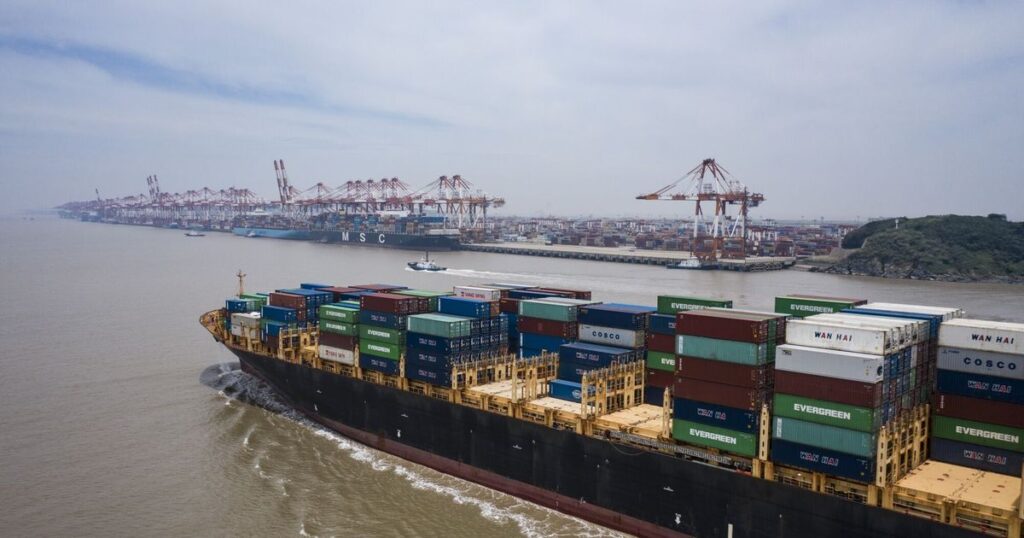President Donald Trump extended a pause of sky-high tariffs on Chinese goods for another 90 days into early November, stabilizing trade ties between the world’s two largest economies.
Trump signed an order extending the truce, according to a person familiar with the matter. The pact, which saw the U.S. and China agree to reduce tit-for-tat tariff hikes and ease export restrictions on rare earth magnets and certain technologies, was due to expire Tuesday.
The text of the order wasn’t immediately available and it was unclear if it included any other changes to U.S. trade policy or to the terms of the arrangement.
Negotiators from both sides reached a preliminary agreement to keep the deal last month in Sweden, and the president’s advisers had expressed optimism he would approve it — but Trump has made last-minute demands and changes in prior trade matters. Had the truce not been extended, U.S. tariffs on Chinese goods would have jumped to at least 54% starting after midnight in New York.
The White House declined multiple requests for comment. Trump, speaking to reporters earlier Monday, demurred when asked if he would extend the deal. CNBC reported earlier on the signing.
“We’ll see what happens,” Trump said when asked if he would extend the deadline. “We’ve been dealing very nicely with China.”
The extension will ease worries of a renewed tariff war that threatens to choke off trade between the U.S. and China. An escalation between Washington and Beijing earlier this year shook global financial markets.
It will also gives the countries more time to discuss other unresolved issues such as duties tied to fentanyl trafficking that Trump has levied on Beijing, American concerns about Chinese purchases of sanctioned Russian and Iranian oil and disagreements around U.S. business operations in China.
The signing may clear the path for Trump to visit China to meet with President Xi Jinping in late October, around the time of an international meeting in South Korea that the U.S. leader is likely to attend.
Trump earlier this year ratcheted up tariffs on Chinese goods, and Beijing responded in kind. U.S. tariffs on Chinese imports ultimately reached 145%, and China curbed access to magnets critical to U.S. manufacturers. The two sides reached a 90-day truce in May, under which the U.S. lowered its China duties to 30% while Beijing reduced levies on U.S. goods to 10% and agreed to resume rare earth exports.
Trump’s willingness to parlay with China has prompted concerns from national security hawks that he’s unwilling to crack down on the the U.S.’s biggest geopolitical rival. Nvidia Corp. and Advanced Micro Devices Inc. reached deals with the Trump administration to secure export licenses by agreeing to pay 15% of their revenues from certain Chinese artificial intelligence chip sales to the U.S. government.
Trump earlier Monday also signaled openness to separately allowing Nvidia to sell a scaled-back version of its most advanced AI chip to China, saying that “it’s possible I’d make a deal.”
With the deadline nearing, Trump on Sunday had called on Beijing to quadruple purchases of American soybeans, something he said would held reduce the U.S. trade deficit with China.
Trump’s decision to extend the truce follows two days of discussions in Stockholm in July led by U.S. Treasury Secretary Scott Bessent and Chinese Vice Premier He Lifeng — the third round of talks between the Washington and Beijing in less than three months.
While Chinese officials and the Communist Party’s official newspaper had signaled satisfaction with the Stockholm talks, and U.S. Cabinet secretaries predicted an extension, the pact remained fragile. Bessent had said that any decision to extend the deal would be up to Trump.
Rare earths
At issue in the ongoing dialogue is how the two countries will seek to maintain a stable trading relationship while applying barriers like tariffs and export controls to limit each other’s progress in critical sectors including battery technology, defense and semiconductors.
Both sides have been taking steps to turn down the temperature and reduce flashpoints recently, with Chinese exports of rare earth magnets starting to recover in June and the U.S. saying it would approve shipments of a semiconductor used for artificial intelligence that it had blocked.
U.S. Trade Representative Jamieson Greer, who participated in the Stockholm negotiations, has sounded an optimistic note on discussions with China over rare earth flows, saying that the U.S. had secured commitments about their supply.
“We’re focused on making sure that magnets from China to the United States and the adjacent supply chain can flow as freely as it did before the control,” Greer told CBS’s Face the Nation in a recent interview. “And I would say we’re about halfway there.”
Flows of rare earth magnets from China to the U.S. rose to 353 tons in June, up from just 46 tons in May, according to the latest customs data. Total shipments were still substantially lower than before Beijing launched export controls in early April.
Sales of advanced AI chips remain an issue, despite Trump’s decision to relax export controls. Chinese authorities in late July summoned Nvidia to discuss alleged security vulnerabilities related to its H20 chips.
Tariff push
China-U.S. negotiations have been on a separate track from other talks the Trump administration has held with trading partners as it moves to implement sweeping so-called reciprocal tariffs and industry-specific levies on other economies.
Trump’s 30% duties comprised a 20% levy tied to fentanyl and a 10% baseline charge. That’s on top of existing tariffs on certain Chinese products from his first term.
Bloomberg’s Paul Abelsky, Charlie Duxbury and Olivia Tam contributed.

